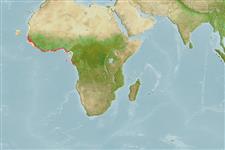>
Carangaria/misc (Various families in series Carangaria) >
Polynemidae (Threadfins)
Etymology: Polydactylus: Greek, poly = a lot of + greek, daktylos = finger (Ref. 45335).
More on author: Cuvier.
Environment: milieu / climate zone / depth range / distribution range
Ökologie
seewasser; süßwasser; brackwasser demersal; tiefenbereich 15 - 55 m (Ref. 10799). Tropical; 22°N - 5°S, 26°W - 13°E (Ref. 57343)
Eastern Atlantic: Senegal to Angola (Ref. 57402). Also reported from Mauritania (Ref. 55783).
Size / Gewicht / Alter
Maturity: Lm ? range ? - ? cm
Max length : 200 cm TL Männchen/unbestimmt; (Ref. 57402); common length : 150 cm TL Männchen/unbestimmt; (Ref. 3659); max. veröff. Gewicht: 75.0 kg (Ref. 7386)
Kurzbeschreibung
Morphologie | Morphometrie
Rückenflossenstacheln (insgesamt): 9; Rückenflossenweichstrahlen (insgesamt): 12-13; Afterflossenstacheln 3; Afterflossenweichstrahlen: 11 - 12. Diagnosis: pectoral fin with 4 threadlike filaments (Ref. 57402, 81658). Pectoral fin inserted very low on body, generally somewhat longer than upper part of fin (Ref. 57402).
Occurs in shallow coastal waters, over sandy and muddy bottoms, sometimes in brackish habitats (Ref. 57343, 81658). Enters estuaries (Ref. 57402), occasionally caught in fresh water (Ref. 57402, 81658). Very large specimens are only found in marine waters (Ref. 81658). Feeds on crustaceans and fishes (Ref. 10799, 81658). Flesh fairly tasteful (Ref. 57402).
Life cycle and mating behavior
Geschlechtsreife | Fortpflanzung | Ablaichen | Eier | Fecundity | Larven
Motomura, H., 2004. Threadfins of the world (Family Polynemidae). An annotated and illustrated catalogue of polynemid species known to date. FAO Spec. Cat. Fish. Purp. Rome: FAO. 3:117 p. (Ref. 57343)
IUCN Rote Liste Status (Ref. 130435)
Bedrohung für Menschen
Harmless
Nutzung durch Menschen
Fischereien: kommerziell; Sportfisch: ja
Mehr Information
NamenSynonymeMetabolismusRäuberÖkotoxikologieFortpflanzungGeschlechtsreifeAblaichenSpawning aggregationFecundityEierEientwicklung
ReferenzenAquakulturAquakultur ProfilZuchtlinienGenetikElectrophoresesVererbbarkeitKrankheitenVerarbeitungNutrientsMass conversion
PartnerBilderStamps, Coins Misc.LauteCiguateraGeschwindigkeitSchwimmstilKiemenoberflächeOtolithsGehirngrößeSehfähigkeit
Tools
Zusatzinformationen
Download XML
Internet Quellen
Estimates based on models
Preferred temperature (Ref.
123201): 22.3 - 28, mean 26 °C (based on 48 cells).
Phylogenetic diversity index (Ref.
82804): PD
50 = 0.5000 [Uniqueness, from 0.5 = low to 2.0 = high].
Bayesian length-weight: a=0.00661 (0.00510 - 0.00855), b=3.09 (3.03 - 3.15), in cm total length, based on LWR estimates for this species (Ref.
93245).
Trophic level (Ref.
69278): 4.0 ±0.66 se; based on food items.
Generation time: 2.7 ( na - na) years. Estimated as median ln(3)/K based on 2
growth studies.
Widerstandsfähigkeit (Ref.
120179): mittel, Verdopplung der Population dauert 1,4 - 4,4 Jahre. (K=0.34-0.41; assuming tm=3-4).
Prior r = 0.57, 95% CL = 0.37 - 0.85, Based on 3 stock assessments.
Fishing Vulnerability (Ref.
59153): Moderate vulnerability (44 of 100).
Climate Vulnerability (Ref.
125649): Very high vulnerability (87 of 100).
Nutrients (Ref.
124155): Calcium = 59.4 [32.4, 109.8] mg/100g; Iron = 0.818 [0.418, 1.451] mg/100g; Protein = 20.1 [18.5, 21.7] %; Omega3 = 0.213 [0.132, 0.349] g/100g; Selenium = 79.1 [38.5, 162.9] μg/100g; VitaminA = 6.04 [2.46, 14.30] μg/100g; Zinc = 0.742 [0.514, 1.115] mg/100g (wet weight);
